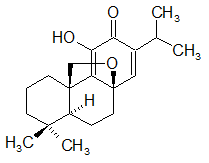Salvia pachyphylla
Salvia pachyphylla (Blue sage, Mountain desert sage) is a perennial shrub native to California, Nevada, and Arizona. In California, it grows between 5,000 to 10,000 ft (1,500 to 3,000 m) elevation on dry rocky slopes, blooming from July to September. It reaches 1 to 2 ft (0.30 to 0.61 m) high, with blue-violet flowers, rarely rose, growing in dense clusters.[1][2]

| Salvia pachyphylla | |
|---|---|
.jpg) | |
| Scientific classification | |
| Kingdom: | Plantae |
| Clade: | Tracheophytes |
| Clade: | Angiosperms |
| Clade: | Eudicots |
| Clade: | Asterids |
| Order: | Lamiales |
| Family: | Lamiaceae |
| Genus: | Salvia |
| Species: | S. pachyphylla |
| Binomial name | |
| Salvia pachyphylla Epling ex Munz | |
In the course of a study of the chemical composition of the flora used in Latin American popular medicine, Ivan C. Guerrero and coworkers have performed phytochemical studies of extracts of the aerial parts from Salvia pachyphylla and Salvia clevelandii . S. pachyphylla is used by indigenous communities for its medicinal properties in the treatment of flu symptom. The major secondary metabolites isolated from these species and the cytotoxic effects against five human cancer cells were reported for eight of the compounds obtained: carnosol, rosmanol, 20-deoxocarnosol, carnosic acid, isorosmanol, 7-methoxyrosmanol, 5,6-didehydro-O-methylsugiol, 8β-hydroxy-9(11),13-abietadien-12-one, 11,12-dioxoabieta-8,13-diene, and 11,12-dihydroxy-20-norabieta-5(10),8,11,13-tetraen-1-one and pachyphyllone.[3]
Notes
- Vizgirdas, Ray S.; Edna M. Rey-Vizgirdas (2006). Wild Plants of the Sierra Nevada. University of Nevada Press. p. 120. ISBN 978-0-87417-535-6.
- McMinn, Howard (1951). An illustrated manual of California shrubs. University of California Press. p. 475. ISBN 978-0-520-00847-2.
- Ivan C. Guerrero, Lucia S. Andres, Leticia G. Leon, Ruben P. Machin, Jose M. Padron, Javier G. Luis, and Jose Delgadillo. Abietane Diterpenoids from Salvia pachyphylla and S. clevelandii with Cytotoxic Activity against Human Cancer Cell Lines. J. Nat. Prod. (2006) 69, 1803-1805